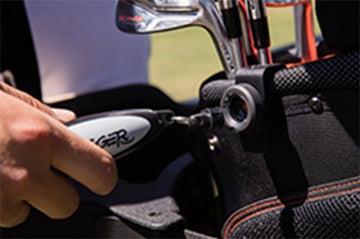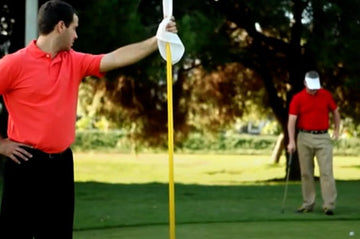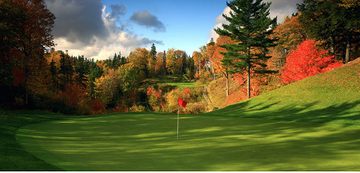Golf Courses: Augusta National
by
Jeremiah Bohannon
on
Apr 03, 2012
The Frogger "Killer Courses" articles are typically about killer courses anyone can play. Because it is Masters week we're changing up the rules a bit to cover a course you probably can't and probably won't ever play, Augusta National Golf Club.
[caption id="attachment_3054" align="aligncenter" width="500"]
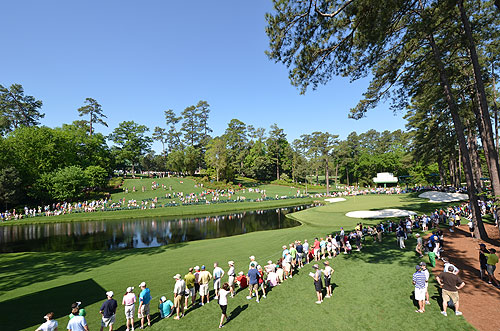
Hole 16 at Augusta National. Photo courtesy of HookedOnGolfBlog.com[/caption]
Augusta National Golf Club is of course, the home of the Masters Tournament. The Masters is golf's "first right of spring," denoting the official beginning of golf season both for amateurs and pro golf.
Architects
Bobby Jones and Allister Mackenzie worked together on the design of "the National." Machenzie was the earth mover and Jones provided the information on how he wanted shots set up. The construction of the course began in 1931 and was completed in 1932. Two years later the first Masters, known back then as the Augusta National Invitation Tournament was contested.
Location
Augusta National is located in Augusta, Georgia. The course is well known for its thousands of beautiful blooming plants, primarily Azaleas. The course rests on the location of a former nursery.
Challenges
Augusta National is known for its very undulating and hilly terrain. That terrain, mixed with small and deadly fast greens make the course very challenging for the best players in the world.
In designing the course, Bobby Jones set up many holes with lies which influence certain shot shapes like draws or fades. But in setting up the greens to receive approach shots, he set up the opposite for the approach. For instance, hole #9 is a par-4 dogleg left. The players' drives usually end up on a down slope which runs away from the player. That sort of lie promotes a fade. But keeping an approach on the green is best served by hitting a draw. So Jones set up the approach to influence a fade and force the player to execute even more by making a draw the best shot to approach.
#13 is another example. The 2nd and/or 3rd shots to this great par-5 are from a lie which has the ball above a right handed player's feet. That situation would promote a draw. But the green is best approached by hitting a fade. See the photo below.
[caption id="attachment_3053" align="aligncenter" width="500"]
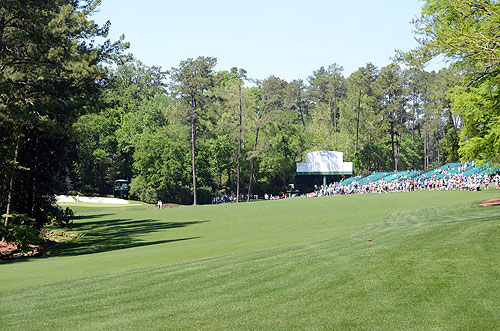
Hole 13 - Par-5 - Photo courtesy of HookedOnGolfBlog.com[/caption]
The greens at the Masters are the primary defense of the course. The greens may look large on TV, but in person they're not. The speed of the greens is never quoted or mentioned by the Masters tournament committee. But many theorize they're as high as 12-14 on the stimp meter. With the slopes and slants these greens have, that sort of speed makes them... well, crazy tough.
Check out the sloping of the first hole's putting surface. Also take note what would happen when one misses the green.
[caption id="attachment_3052" align="aligncenter" width="500"]

#1 green. Photo courtesy of HookedOnGolfBlog.com[/caption]
The Masters
Now that you know a little more about the course, you may have a better idea who you'd pick to win the Masters based on their strengths and weaknesses.
Contact
Normally in this section of Killer Courses we put a course's contact information so readers can get in touch with them to book rounds of golf. Since this is a special killer courses posting, we'll simply put the one place you can go for any information about Augusta National or the Masters:
Masters.com
 Hole 16 at Augusta National. Photo courtesy of HookedOnGolfBlog.com[/caption]
Augusta National Golf Club is of course, the home of the Masters Tournament. The Masters is golf's "first right of spring," denoting the official beginning of golf season both for amateurs and pro golf.
Architects
Bobby Jones and Allister Mackenzie worked together on the design of "the National." Machenzie was the earth mover and Jones provided the information on how he wanted shots set up. The construction of the course began in 1931 and was completed in 1932. Two years later the first Masters, known back then as the Augusta National Invitation Tournament was contested.
Location
Augusta National is located in Augusta, Georgia. The course is well known for its thousands of beautiful blooming plants, primarily Azaleas. The course rests on the location of a former nursery.
Challenges
Augusta National is known for its very undulating and hilly terrain. That terrain, mixed with small and deadly fast greens make the course very challenging for the best players in the world.
In designing the course, Bobby Jones set up many holes with lies which influence certain shot shapes like draws or fades. But in setting up the greens to receive approach shots, he set up the opposite for the approach. For instance, hole #9 is a par-4 dogleg left. The players' drives usually end up on a down slope which runs away from the player. That sort of lie promotes a fade. But keeping an approach on the green is best served by hitting a draw. So Jones set up the approach to influence a fade and force the player to execute even more by making a draw the best shot to approach.
#13 is another example. The 2nd and/or 3rd shots to this great par-5 are from a lie which has the ball above a right handed player's feet. That situation would promote a draw. But the green is best approached by hitting a fade. See the photo below.
[caption id="attachment_3053" align="aligncenter" width="500"]
Hole 16 at Augusta National. Photo courtesy of HookedOnGolfBlog.com[/caption]
Augusta National Golf Club is of course, the home of the Masters Tournament. The Masters is golf's "first right of spring," denoting the official beginning of golf season both for amateurs and pro golf.
Architects
Bobby Jones and Allister Mackenzie worked together on the design of "the National." Machenzie was the earth mover and Jones provided the information on how he wanted shots set up. The construction of the course began in 1931 and was completed in 1932. Two years later the first Masters, known back then as the Augusta National Invitation Tournament was contested.
Location
Augusta National is located in Augusta, Georgia. The course is well known for its thousands of beautiful blooming plants, primarily Azaleas. The course rests on the location of a former nursery.
Challenges
Augusta National is known for its very undulating and hilly terrain. That terrain, mixed with small and deadly fast greens make the course very challenging for the best players in the world.
In designing the course, Bobby Jones set up many holes with lies which influence certain shot shapes like draws or fades. But in setting up the greens to receive approach shots, he set up the opposite for the approach. For instance, hole #9 is a par-4 dogleg left. The players' drives usually end up on a down slope which runs away from the player. That sort of lie promotes a fade. But keeping an approach on the green is best served by hitting a draw. So Jones set up the approach to influence a fade and force the player to execute even more by making a draw the best shot to approach.
#13 is another example. The 2nd and/or 3rd shots to this great par-5 are from a lie which has the ball above a right handed player's feet. That situation would promote a draw. But the green is best approached by hitting a fade. See the photo below.
[caption id="attachment_3053" align="aligncenter" width="500"] Hole 13 - Par-5 - Photo courtesy of HookedOnGolfBlog.com[/caption]
The greens at the Masters are the primary defense of the course. The greens may look large on TV, but in person they're not. The speed of the greens is never quoted or mentioned by the Masters tournament committee. But many theorize they're as high as 12-14 on the stimp meter. With the slopes and slants these greens have, that sort of speed makes them... well, crazy tough.
Check out the sloping of the first hole's putting surface. Also take note what would happen when one misses the green.
[caption id="attachment_3052" align="aligncenter" width="500"]
Hole 13 - Par-5 - Photo courtesy of HookedOnGolfBlog.com[/caption]
The greens at the Masters are the primary defense of the course. The greens may look large on TV, but in person they're not. The speed of the greens is never quoted or mentioned by the Masters tournament committee. But many theorize they're as high as 12-14 on the stimp meter. With the slopes and slants these greens have, that sort of speed makes them... well, crazy tough.
Check out the sloping of the first hole's putting surface. Also take note what would happen when one misses the green.
[caption id="attachment_3052" align="aligncenter" width="500"] #1 green. Photo courtesy of HookedOnGolfBlog.com[/caption]
The Masters
Now that you know a little more about the course, you may have a better idea who you'd pick to win the Masters based on their strengths and weaknesses.
Contact
Normally in this section of Killer Courses we put a course's contact information so readers can get in touch with them to book rounds of golf. Since this is a special killer courses posting, we'll simply put the one place you can go for any information about Augusta National or the Masters: Masters.com
#1 green. Photo courtesy of HookedOnGolfBlog.com[/caption]
The Masters
Now that you know a little more about the course, you may have a better idea who you'd pick to win the Masters based on their strengths and weaknesses.
Contact
Normally in this section of Killer Courses we put a course's contact information so readers can get in touch with them to book rounds of golf. Since this is a special killer courses posting, we'll simply put the one place you can go for any information about Augusta National or the Masters: Masters.com












